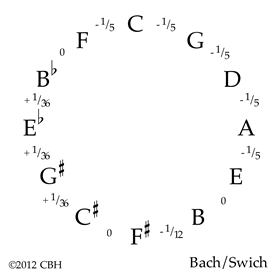Technical Library
TEMPERAMENTS XXVII: Bach/Swich
Entire Contents Copyright © 2012 CBHTechnical LibraryTEMPERAMENTS XXVII: Bach/Swich Entire Contents Copyright © 2012 CBH |
 I suspect it was rather optimistic for Dr Lehman to title his original 2005 article “Bach’s
extraordinary temperament: our Rosetta Stone”, when so many alternate readings of the Bach squiggle have provided quite different translations. The real Rosetta stone, of course, was definitive.
I suspect it was rather optimistic for Dr Lehman to title his original 2005 article “Bach’s
extraordinary temperament: our Rosetta Stone”, when so many alternate readings of the Bach squiggle have provided quite different translations. The real Rosetta stone, of course, was definitive.
Yet another possible interpretation of the Bach squiggle appeared in the August 2011 issue of Early Music under the title “Further thoughts on Bach’s 1722 temperament”. The extract of the Italian Luigi Swich’s article can be viewed on the Oxford University Press website. The author notes Bach’s “remarkably simple way he conveyed his own tuning method”, yet perhaps old Bach wasn’t as clear as some would like: If nothing else, what can be gleaned from the discussion on these pages are the considerable variant readings of the squiggle.
 Here, the squiggle found on the title
page of Das wohltemperirte Clavier is regarded running in fourths from F through the flats, with the same C reference point from Clavier as in Bach/Lehman.
Here, the squiggle found on the title
page of Das wohltemperirte Clavier is regarded running in fourths from F through the flats, with the same C reference point from Clavier as in Bach/Lehman.
However, in contrast with Lehman’s sixth-comma approach, Swich’s temperament is based on the five fifths from the sharp side of F being narrowed by a fifth-comma. He observes the same as Kellner about the equal-beating quality of a fifth-comma fifth and its major third—if that is desirable, or something Bach would have insisted upon.
The large chain of fifth-comma fifths gives improved thirds over Bach/Lehman in the keys close to the sharp side of C. However, this comes at the cost of wider than Pythagorean thirds on F♯ and C♯—and the little strangeness of three ever-so-slightly wide fifths closing the circle, although only by a thirty-sixth-comma each!
Here’s how you can go about setting Bach/Swich by ear:
1. Tune your a' to the tuning fork, and tune down a pure octave to a.
2. Tune f' pure below a' first of all, then flatten it until you hear three distinct beats per second, a familiar beat rate although up an octave if you are used to Vallotti. Tune down an octave to f: The interval f–a must beat at half that, just one and a half times per second.
3. It is characteristic of fifth-comma temperaments that the Major third beats at the same speed as the fifth above the tonic. Therefore, tune middle c' pure above your f, then flatten middle c' until you hear the same one and a half distinct beats per second for both intervals: f–a is wide and f–c' narrow.
4. The four remaining fifth-comma fifths around the circle between C and E must now be made equally narrow and rough. Find your g' above middle c', again tuning the fifth pure and then squeezing it until it beats twice per second. (You’re a good deal higher up the keyboard now, so bear in mind that if this interval is the same theoretical size as the last, it’s going to beat just that much faster and trick you into thinking you have actually tuned it rougher: Every octave you go up doubles the beat speed.) Drop down the octave to the pure g.
5. Jam your d' in between g and a', if that is the right phrase to use. First of all, tune d' pure to g, and then commence your juggling act, lowering your d' little by little until your fifth g–d' sounds about the same as your f–c', and d'–a' sounds pretty similar to c'–g'. All these fifths are a fifth-comma narrow, and a little vulgar-sounding by themselves.
6. Tune e' pure above a, then flatten the e' until it again makes a narrow fifth. Drop down an octave to e. Compare f–c', g–d', a–e', c'–g' & d'–a', observing that these intervals—all theoretically the same size—have increasing beat speeds as the pitch ascends.
7. Tune b to make the pure fifth e–b.
8. Tune f♯' pure to b, then lower the f♯' slightly to make an equal-tempered fifth b–f♯'. It will beat somewhat less than once per second. Drop down an octave to f♯.
9. Tune c♯' to make the pure fifth f♯–c♯', and tune down an octave to c♯.
10. Tune b♭ to make the pure fifth b♭–f'.
11. Finally, you must distribute the error remaining in the circle between B♭ and C♯. Tune e♭ pure below b♭, then nudge it down ever so slightly. This interval is wide of pure, but by such a little amount I think you would be lucky to hear any obvious beating at all. Tune a pure octave from e♭ to e♭'.
12. Tune g♯ pure above c♯, then nudge it up slightly to make another infinitesimally wide-of-pure fifth. Compare c♯–g♯ to e♭–b♭—both barely wide fifths, and check that your g♯ also makes a slightly wide fifth with e♭' (really d♯').
Make a final check, if you like, verifying that you have all your fifths in the same place as shown in the diagram: The three pure fifths e–b, f♯–c' and b♭–f'; the three almost-audibly wide fifths c♯–g♯, e♭–b♭ and g♯–d♯'; one equal-tempered fifth b–f♯'; and the five obvious fifth-comma fifths. Bring the rest of your instrument into tune with the bearings area, and you can play some music.
| Pitch nomenclature | |
| Harpsichord Tuning Process | |
| Tuning Bibliography | |
| Technical Library overview | |
| Harpsichords Australia Home Page |